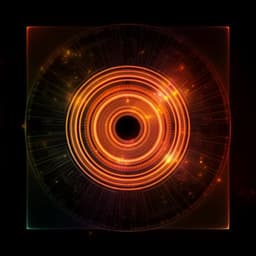
Physics
Unlocking the out-of-plane dimension for photonic bound states in the continuum to achieve maximum optical chirality
L. Kühner, F. J. Wendisch, et al.
This groundbreaking research by Lucca Kühner and team unveils a novel nanofabrication technique that realizes all-dielectric metasurfaces with maximally chiral quasi-bound states in the continuum (BICs). This innovation allows for selective responses to circular polarization, paving the way for advancements in chiral nanophotonics and optical applications like holographic metasurfaces.
~3 min • Beginner • English
Introduction
The study targets precise control of light–matter interaction for different polarization states, a central goal in optics with broad scientific and technological impact. Progress in metasurfaces has shifted from lossy plasmonic systems to lossless all-dielectric platforms and leveraged quasi-bound states in the continuum (qBICs) to engineer radiative coupling and achieve ultrasharp resonances and strong near-fields. However, most realizations rely on in-plane symmetry breaking and planar geometries, limiting functionalities that inherently require three-dimensional structuring, such as holography, generation of optical angular momentum, and chiral interactions. The paper proposes unlocking out-of-plane symmetry breaking by independently controlling resonator heights within all-dielectric metasurfaces, enabling height-driven qBICs and, crucially, maximally chiral qBIC metasurfaces that selectively interact with one circular polarization while remaining transparent to the opposite handedness.
Literature Review
- All-dielectric qBIC metasurfaces have enabled ultrasharp resonances with high Q factors, broad spectral tunability, and enhanced near-fields, overcoming Ohmic losses typical of plasmonic systems.
- Prior qBIC implementations predominantly used in-plane symmetry breaking; the lack of accessible out-of-plane control has hindered applications needing non-planar structures (e.g., holography, OAM generation, chirality sensing, chiral nanophotonics).
- Theoretical works proposed chiral qBICs in in-plane mirror-symmetry-broken systems to approach maximum optical chirality, defined as selective interaction with only one helicity. Yet achieving maximum chirality for arbitrary incidence remains challenging; focusing on specific directions and eigenstates is more tractable.
- Existing experimental demonstrations of maximally chiral responses have been largely confined to microwave frequencies; optical implementations often require complex 3D unit cells and have achieved only weak resonance modulation and small transmission differences between circular handednesses.
Methodology
- Theory and coupled-mode framework: The metasurface response is modeled via coupled-mode theory (CMT), describing interference between a direct background and a resonant qBIC channel. Coupling parameters me to normally incident waves are proportional to volume integrals of the displacement current projected onto the incident polarization (and depend on propagation direction). Power transmission coefficients are expressed through a background transmission term and the complex eigenfrequency, with decay rates composed of radiative and absorptive parts.
- qBIC design principles: Starting from a symmetry-protected anti-parallel electric dipole BIC in a double-rod unit cell with C2v symmetry (p1 = −p2, r1 = r2), the BIC is turned into a qBIC by breaking symmetry either in-plane (e.g., rod length difference ΔL) or out-of-plane (height difference Δh), which modifies dipole magnitudes and effective z-positions, enabling far-field coupling. Combining out-of-plane (Δh) and in-plane (small rotation opening angle θ) perturbations yields a chiral unit cell that breaks all point symmetries.
- Chiral coupling condition: For two equal-magnitude dipoles rotated by θ with a z-displacement Δz induced by Δh, the coupling to LCP/RCP scales as mLR ∝ sin(θ ± kΔz/2). Balancing perturbations via 2θ = kΔz maximizes coupling to one helicity (e.g., LCP) while isolating from the opposite (RCP). A maximally chiral response is obtained when the qBIC lies in a spectrally transparent background with negligible dissipation and exhibits quadratic dependence of decay rate on coupling.
- Numerical simulations: Full-wave simulations (Methods) model transmission and reflection for normally incident light.
• Linearly polarized qBICs: Square lattice period 450 nm; two parallel Si rods per unit with equal footprint 330 × 100 nm², base height 120 nm, and variable height difference Δh. Transmittance spectra under polarization along the rod axis are computed; Q factors extracted via CMT fitting as a function of Δh.
• Chiral qBICs: Square lattice period 550 nm; two rectangular Si rods with identical cross section 160 × 100 nm² and equal length L = 310 nm; rod centers spaced 275 nm. Asymmetry introduced by turning one rod on its side to realize Δh = 60 nm (estimated Δz ≈ 30 nm), and both rods rotated by an opening angle θ away from the y-axis. A sweep over θ determines the optimal angle for maximum ΔT; optimal θ = 8.5° gives selective LCP coupling with resonance near 892 nm. Near-field enhancements are evaluated at resonance.
- Experimental fabrication (overview): A multi-step nanofabrication scheme enables arbitrary resonator height control in all-dielectric metasurfaces. It combines N-step electron-beam lithography (EBL) with N-step deposition to realize N distinct height levels. For N = 2 (this work), plasma-enhanced chemical vapor deposition (PECVD) is used to deposit an amorphous silicon layer (thickness h1 defines the lowest resonator height) on SiO2, followed by EBL, metal deposition of a Cr hard mask, and lift-off to define the first resonator footprint. Subsequent steps (described in Methods) add further height levels via additional deposition and patterning. The smallest realized height difference in this work is 10 nm; in principle, Angstrom-level control is possible using ALD.
Key Findings
- Out-of-plane symmetry breaking via resonator height difference Δh provides direct control over qBIC coupling and linewidth while preserving all-dielectric, low-loss operation.
- Simulations show the resonance is absent for Δh = 0 and emerges with increasing Δh, exhibiting ultrasharp line shapes with Q factors above 10^4 at Δh = 5 nm. Extracted Q factors follow the hallmark inverse quadratic scaling Q ∝ 1/Δh^2.
- The linearly polarized qBIC exhibits strong near-field enhancements with |E|/|E0| exceeding 50 at resonance.
- A chiral qBIC metasurface that breaks all point symmetries is realized by combining Δh with a small in-plane rotation θ. Optimizing θ yields selective coupling to LCP while decoupling from RCP at normal incidence, achieving a pronounced transmission resonance only for LCP near 892 nm with near-field enhancement >20.
- The transmission selectivity metric ΔT is maximized at an opening angle θ = 8.5°, consistent with the design condition 2θ = kΔz. Smaller θ yields weaker chirality; larger θ suppresses the maximum ΔT.
- Under ideal conditions, the blocked circular polarization is reflected rather than absorbed, consistent with a lossless maximally chiral filter behavior.
- Fabrication advances: A scalable multi-step EBL/deposition process enables multi-height all-dielectric metasurfaces; the smallest implemented height difference is 10 nm, and Angstrom-level control is feasible with ALD, suggesting potential for even higher Q and stronger near-field enhancements.
Discussion
The work addresses the key limitation of planar, in-plane symmetry-broken metasurfaces by unlocking the out-of-plane degree of freedom, enabling precise radiative coupling control in all-dielectric qBIC platforms. Height-driven symmetry breaking produces the expected qBIC scaling (Q ∝ 1/Δh^2) and strong near fields, validating the approach within the BIC framework. By balancing out-of-plane and in-plane perturbations, the designed chiral unit cell achieves near-ideal, helicity-selective coupling: it supports an ultranarrow resonance for one circular polarization while remaining transparent (and reflective for the rejected helicity) to the other, approaching the theoretical limit of maximum optical chirality under normal incidence. This selective, low-loss chiral response is fundamentally distinct from conventional CD where one helicity is simply blocked, offering superior performance for polarization filtering. The demonstrated methodology expands the metasurface design space and is directly relevant for applications requiring efficient control over spin and angular momentum of light, including OAM generation, holographic wavefront shaping, and PT-symmetry-broken optical systems.
Conclusion
The paper introduces a multi-height nanofabrication strategy that unlocks out-of-plane symmetry breaking in all-dielectric metasurfaces, enabling height-driven qBIC engineering. The approach yields ultrahigh-Q resonances with strong near-field enhancements and, when combined with a controlled in-plane rotation, realizes a chiral qBIC metasurface with maximized intrinsic chirality: selective coupling to one circular polarization and transparency to the other at normal incidence. This generalizes the metasurface paradigm beyond planar geometries, offering expanded independent design parameters and previously inaccessible functionalities. Future research directions include: extending the concept to broader spectral ranges and incidence angles; integrating atomic-layer-deposition-level height control for even higher Q and stronger fields; exploring dynamic or reconfigurable height asymmetries; and translating the platform to advanced applications such as efficient OAM generation, high-fidelity holography, and PT-symmetric photonic systems.
Limitations
- The maximally chiral response is demonstrated and optimized for normally incident light; achieving maximum chirality for arbitrary incidence directions remains a complex, open challenge.
- Realization of ideal maximum chirality requires operation in a spectrally transparent background with negligible material losses; deviations will reduce selectivity and ΔT.
- The chiral design relies on precise balancing between out-of-plane displacement and in-plane rotation (2θ = kΔz), demanding tight fabrication tolerances.
- Experimental details beyond the initial fabrication steps are not fully provided in the excerpt; the proof-of-concept focuses on two height levels, though the process is scalable to larger N.
Related Publications
Explore these studies to deepen your understanding of the subject.







